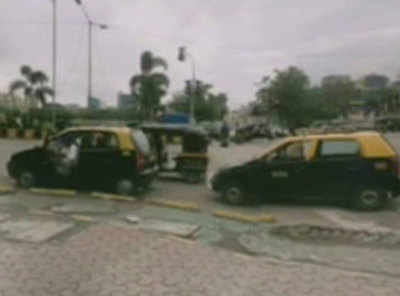- News
- India News
- Google Street View hits MHA curtain
Trending
This story is from June 10, 2016
Google Street View hits MHA curtain
Govt Cites Security, Privacy Concerns To Block 360° Images Of India Online

A Google Street View mapping vehicle is seen in Bengaluru, where the app was briefly in use, in this photo from 2011.
NEW DELHI: Citing security and privacy issues, the Union government has rejected internet giant Google's plans to map Indian cities, tourist spots, hills and rivers for an app which would have allowed you to explore the places through 360-degree images.
According to highly placed sources, the ministry of home affairs, after consultations with the defence and other ministries, has conveyed to Google that its plans to add Indian locations on Street View cannot be given permission.
The security establishment in particular is wary of allowing such image-capturing given that the planning for 26/11 is believed to have involved photographic reconnaissance of targets by Pakistani-American David Coleman Headley.
The sources said the rejection came after a detailed analysis by security agencies and defence forces, which felt that allowing Google to cover India for the app would compromise the country's security interests. In January this year, terrorists from Jaish-e-Mohammed managed to sneak into the Indian Air Force base at Pathankot, Punjab, and almost reached the site where tactical assets, planes and helicopters were parked. If Google Street view imagery is allowed, terrorists may use it for recce of defence and intelligence establishments as well as important government buildings.
Google wanted to cover most of India through Google Street View. It was launched in 2007 in several US cities, and has since expanded to include cities and rural areas worldwide. Extensively used in the US, Canada and many European countries, it was available in Bengaluru for a while before being disallowed following concerns raised by the local police.
In partnership with the Archaeological Society of India, Google had also, on an experimental basis, launched Street View at tourist sites like the Taj Mahal, Red Fort, Qutub Minar, Varanasi river bank, Nalanda University, Mysore Palace, and Chinnaswamy stadium. Street View imagery displays a panoramic view built with stitched images. The photography is done mainly by a car, complemented by work by trekkers and walkers, as well as via boats, snowmobiles, camels and underwater apparatus.
Google officials had told the government that the company wanted to use the app for tourism and disaster management. A formal proposal had been submitted in July last year.
According to highly placed sources, the ministry of home affairs, after consultations with the defence and other ministries, has conveyed to Google that its plans to add Indian locations on Street View cannot be given permission.
The security establishment in particular is wary of allowing such image-capturing given that the planning for 26/11 is believed to have involved photographic reconnaissance of targets by Pakistani-American David Coleman Headley.
The sources said the rejection came after a detailed analysis by security agencies and defence forces, which felt that allowing Google to cover India for the app would compromise the country's security interests. In January this year, terrorists from Jaish-e-Mohammed managed to sneak into the Indian Air Force base at Pathankot, Punjab, and almost reached the site where tactical assets, planes and helicopters were parked. If Google Street view imagery is allowed, terrorists may use it for recce of defence and intelligence establishments as well as important government buildings.
Minister of state for home affairs Kiren Rijiju said issues related to internet-based apps would be resolved once the proposed Geospatial Information Regulation Bill, 2016 comes into force.
Google wanted to cover most of India through Google Street View. It was launched in 2007 in several US cities, and has since expanded to include cities and rural areas worldwide. Extensively used in the US, Canada and many European countries, it was available in Bengaluru for a while before being disallowed following concerns raised by the local police.
In partnership with the Archaeological Society of India, Google had also, on an experimental basis, launched Street View at tourist sites like the Taj Mahal, Red Fort, Qutub Minar, Varanasi river bank, Nalanda University, Mysore Palace, and Chinnaswamy stadium. Street View imagery displays a panoramic view built with stitched images. The photography is done mainly by a car, complemented by work by trekkers and walkers, as well as via boats, snowmobiles, camels and underwater apparatus.
Google officials had told the government that the company wanted to use the app for tourism and disaster management. A formal proposal had been submitted in July last year.
End of Article
FOLLOW US ON SOCIAL MEDIA










